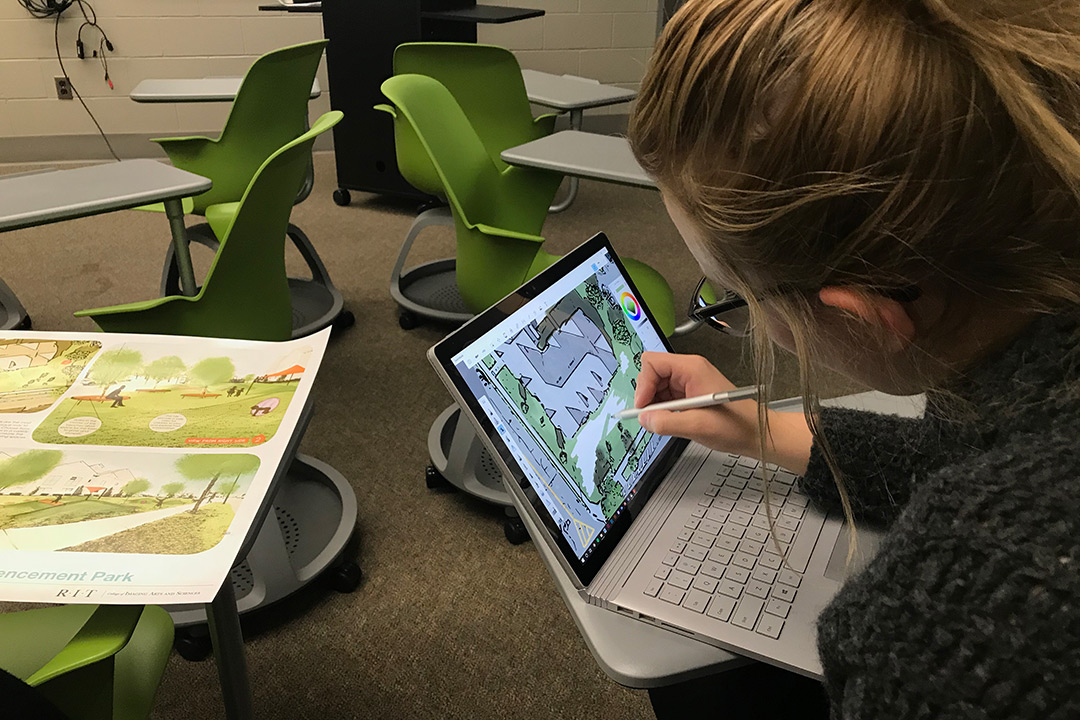Student Spotlight: Park design chosen for KaBOOM! grant
Student Spotlight: Madison Miller, Jim Chen and Stefani Schultz, third-year interior design students
Stefani Schultz is incredibly proud of Elevate and is excited to see a design she worked on come to life.
Three interior design students, Madison Miller from Bradford, N.Y.; Jim Chen from Beijing, China; and Stefani Shultz from Buffalo, N.Y., designed a play area for the Sojourner Home at Wilson Commencement Park in Rochester. This collaborative project between RIT’s interior design program and the Sojourner Home at Wilson Commencement Park received a $63,000 grant to make the students’ design a reality. The project, Elevate, will be transforming an empty lot behind a city bus stop at Wilson Commencement Park into a safe play area.
Miller, Chen and Schultz worked on applying for the KaBOOM! grant with Sean Hawkins, director of the Sojourner Home at Wilson Commencement Park. This grant is funded through KaBOOM! and the Ralph C. Wilson Jr. Foundation as a part of the Play Everywhere Challenge. Both organizations teamed up to award $1 million in grants, ranging from $10,000 to $80,000 per grant, to projects across western New York and southeast Michigan that will “integrate play into everyday life and unexpected places.” Elevate was one of 23 projects that received money from this challenge.
The group wants to give the residents of Wilson Commencement Park a view of nature to offset all of the man-made structures surrounding them. The goal is to create something that is simple, beautiful to look at and fun to play on. Rather than utilizing plastics or metal to create a traditional playground, the group will be embracing nature by creating hills, tunnels, ladders and a maze out of the natural landscape of the site.
The group is expected to break ground on the park in April 2019.
Question: When was this idea born?
Miller: We came up with the idea in a class called design issues. The people from Wilson Commencement Park came in and explained what they wanted for the lot, and then we had to come up with a design to present to them. We were assigned the project on a Wednesday and had to have it done by the following Wednesday, so we had to work pretty quickly.
Question: How did you decide on the designs for specific play elements?
Chen: We knew from previous research we had done in class that playing in nature is helpful for children, especially females. It triggers a biophilic response and helps encourage them to be outside more often. We also knew that there was a large concentration of young girls who lived at Wilson Commencement Park, so that factor helped guide our choice to focus on more natural elements.
Question: How did the landscape influence your design plan?
Schultz: When we were given the assignment, each of us went out there to see the site, get dimensions and survey the land. When we got there, it was easier to see our vision for what we wanted. While we were measuring, we saw there were natural dips and higher elevations across the lot because there was a drain in the middle of the site. We knew excavating the land and making it perfectly flat would cost money, so we were trying to think about how to work with the existing landscape. The location downtown is surrounded by buildings and there are really no green areas aside from that empty lot, so we thought that focusing on something more natural would liven up the area.
Question: What were some challenges you faced when designing the play area?
Miller: I think that the concept came easy to us, but the challenge was working with materials. When selecting materials, we had to think about how the weather would affect our park or the area that the park would be in. We also had to think about the fact that children wouldn’t be the only ones using it. An adult could be playing there too, so you can’t just make everything child-sized. Thinking about all these factors was difficult.
Question: What was your reaction when you received the KaBOOM! grant?
Chen: I know Stefani was very happy about that. Madison almost didn’t believe it and she was really shocked. When Stefani texted me about our project being selected to present to KaBOOM!, I joked with her and told her that I knew we would be picked because our design was so great. I was in China when I found out we actually got the grant, so I didn’t know until I read the email a little later. I was happy we received it because I think our design is quite approachable budget-wise.
Question: What are the next steps for the project?
Schultz: Every Thursday at 8 a.m. we have meetings to discuss products and the budget, and to have meetings with different contractors to make sure we have everything in order. We are working on getting publicity for the project while we wait to install it. We’re hoping to bring in community members outside of our group to help build the park, which is something that KaBOOM! really appreciates, so we are trying to coordinate that as well.
 Madison Miller, left, and Stefani Schultz, right, work on design sketches for the play area at Wilson Commencement Park.
Madison Miller, left, and Stefani Schultz, right, work on design sketches for the play area at Wilson Commencement Park. The concept sketch for the park places an emphasis on the natural elements of the park.
The concept sketch for the park places an emphasis on the natural elements of the park.











